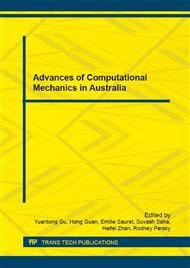[1]
Z. Zúberová, Y. Estrin, T.T. Lamark, M. Janeček, R.J. Hellmig, and M. Krieger, Effect of equal channel angular pressing on the deformation behaviour of magnesium alloy AZ31 under uniaxial compression. Journal of Materials Processing Technology, 2007. 184(1–3): pp.294-299.
DOI: 10.1016/j.jmatprotec.2006.11.098
Google Scholar
[2]
C.M. Sellars and W.J. McTegart, On the mechanism of hot deformation. Acta Metallurgica, 1966. 14(9): pp.1136-1138.
DOI: 10.1016/0001-6160(66)90207-0
Google Scholar
[3]
J.D. Robson, Microstructural evolution in aluminium alloy 7050 during processing. Materials Science and Engineering: A, 2004. 382(1–2): pp.112-121.
DOI: 10.1016/j.msea.2004.05.006
Google Scholar
[4]
H.E. Hu, L. Zhen, L. Yang, W.Z. Shao, and B.Y. Zhang, Deformation behavior and microstructure evolution of 7050 aluminum alloy during high temperature deformation. Materials Science and Engineering: A, 2008. 488(1–2): pp.64-71.
DOI: 10.1016/j.msea.2007.10.051
Google Scholar
[5]
J. Li, F. Li, J. Cai, R. Wang, Z. Yuan, and F. Xue, Flow behavior modeling of the 7050 aluminum alloy at elevated temperatures considering the compensation of strain. Materials & Design, 2012. 42: pp.369-377.
DOI: 10.1016/j.matdes.2012.06.032
Google Scholar
[6]
W.C. Chen, I.V. Samarasekera, and E.B. Hawbolt, Fundamental phenomena governing heat transfer during rolling. Metallurgical Transactions A, 1993. 24(6): pp.1307-1320.
DOI: 10.1007/bf02668199
Google Scholar
[7]
C.H. Moon and Y. Lee, Approximate Model for Predicting Roll Force and Torque in Plate Rolling with Peening Effect Considered. ISIJ International, 2008. 48(10): pp.1409-1418.
DOI: 10.2355/isijinternational.48.1409
Google Scholar
[8]
J.R. Davis, Aluminum and Aluminum Alloys. (2005).
Google Scholar
[9]
S.F. Wong, P.D. Hodgson, C.J. Chong, and P.F. Thomson, Physical modelling with application to metal working, especially to hot rolling. Journal of Materials Processing Technology, 1996. 62(1–3): pp.260-274.
DOI: 10.1016/0924-0136(95)02219-8
Google Scholar
[10]
T.J. Turner, M.P. Miller, and N.R. Barton, The influence of crystallographic texture and slip system strength on deformation induced shape changes in AA 7050 thick plate. Mechanics of Materials, 2002. 34(10): pp.605-625.
DOI: 10.1016/s0167-6636(02)00160-6
Google Scholar


